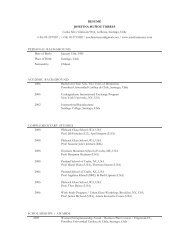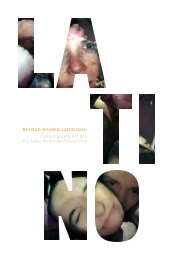BEYOND SHARED LANGUAGE - Society for Contemporary Craft
BEYOND SHARED LANGUAGE - Society for Contemporary Craft
BEYOND SHARED LANGUAGE - Society for Contemporary Craft
You also want an ePaper? Increase the reach of your titles
YUMPU automatically turns print PDFs into web optimized ePapers that Google loves.
The same could be said of the work of Nuyorican Miguel Luciano. In Pure Plantainum, he used<br />
casting techniques, in this case platinum, to cover a plantain, with which many Latinos in the United<br />
States are identified.The title proposes a word game, taking advantage of the phonetic similarity of the<br />
words. In this way, the beauty of the precious metal contrasts with the organic character and, there<strong>for</strong>e,<br />
the perishable nature of the fruit. Luciano mentions paradigmatic Puerto Rican artworks, from El pan<br />
nuestro (1905) by Ramón Frade to La transculturación del puertorriqueño (1975), by Carlos Irizarry and<br />
alludes to pop-culture and its glorification of assumed Latin pride, which exploit even more than they<br />
combat marginality. His previous works in painting and installation, also explored this overlapping, in<br />
particular relating to the Nuyorican cultural identity, a blending of the terms ‘‘New York’’ and ‘‘Puerto<br />
Rican,’’ referring to the members of Diaspora located in or around New York.Without being too moralizing,<br />
<strong>for</strong> Luciano the luxury of a bling-bling (and the pride associated to it) hides a putrid interior.<br />
Identity occupies an essential position in the sculpture of two other artists, who coincidently work with<br />
fabric. Elia Alba has made the fabrication of masks the corner stone of her work. Descended from<br />
Dominican Republic emigrants, and a community who began to define its own voice in the visual arts<br />
with artists like Freddy Rodríguez, Scherezade and Nicolás Dumit Estévez, Alba has undertaken the<br />
subject of miscegenation and racial indetermination in pieces like La jabá, a kind of parody of the<br />
famous, early 20th century Banana Dance by Josephine Baker. The bananas on the dancer’s skirt (in<br />
fact a transvestite incarnated by Dumit) are replaced by Dominican faces, which are called “bananos.”<br />
From here, the masks have crossed a path that has allowed them to surpass the “deja vu” of certain<br />
Photoshop digital art. Occasionally in Alba’s work, the <strong>for</strong>ms possess a more visceral tone like the series<br />
of costumes in which she reproduces the feminine sexual organs in three variants: white, black and mulatto.<br />
Conversely,Tamara Kostianovsky incarnates another perspective on the subject, placing herself in the<br />
crossing between her national and personal identities. Her depiction of animal flesh makes reference to<br />
the main Argentinean industry. But her own clothes, which she uses to construct the soft sculptures,<br />
contribute other layers of meaning. Kostianovsky narrates that her determination to use her clothes<br />
was <strong>for</strong>tuitous at the beginning of her career, when in 2000, because of the economic crisis in her<br />
country, her bank account was frozen and she was <strong>for</strong>ced to make art with what she had at hand; but<br />
later, it became a political decision. Literally, Kostianovsky personalizes the conflict against implicit<br />
violence in animal sacrifice, cannibalizing her own clothes.The fiber of the weave remembers almost<br />
with cruel fidelity the fiber of the flesh. Likewise, the Venezuelan Pedro Cruz-Castro metaphorically<br />
attempts to return the cured and processed materials to their natural state as he draws figures on<br />
hides—of incomplete—domesticated (exploited) animals (pig, goat, horse). Previously, he worked<br />
with wood, integrating trees into antique furniture.<br />
12




